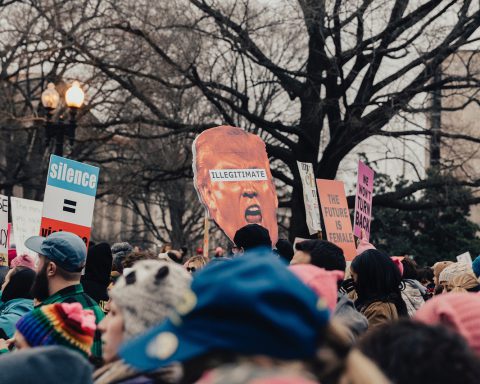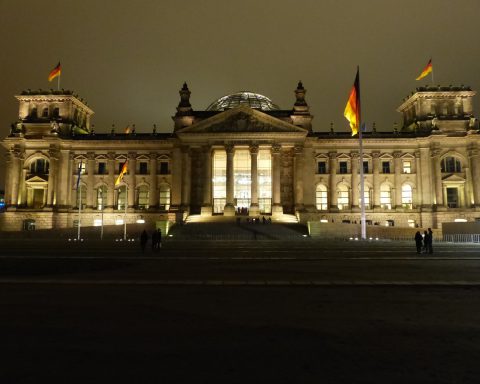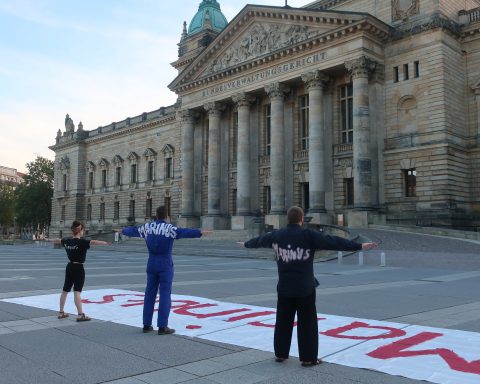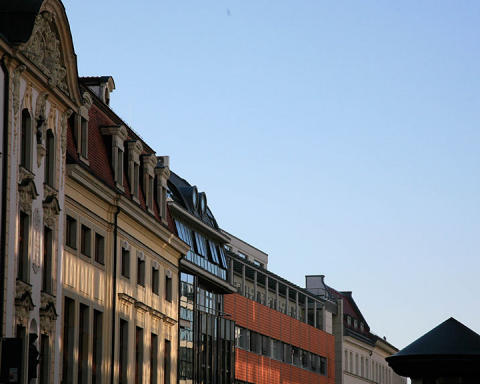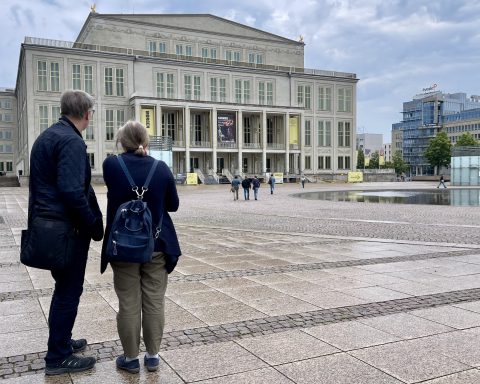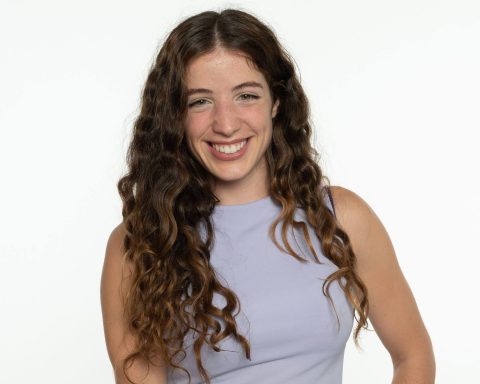Next time you’re in the Leipzig city center, look closely between the stores, past the crowds of shoppers, and on unassuming street corners. You can still find reminders of the Peaceful Revolution, a movement that happened less than 30 years ago and helped change the course of German history and society.
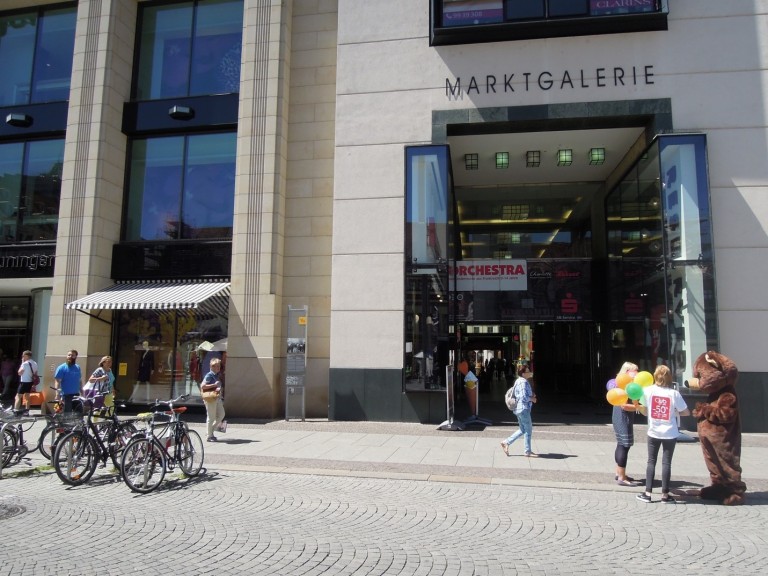
As an American, all I really knew about the reunification of Germany was based on a clip of David Hasselhoff in an electric jacket singing on top of the Berlin Wall, which is to say… not a lot. I only had a fuzzy idea of the steps that led up to that moment.
But as a former history student, as soon as I learned that my new residence was the home of the Peaceful Revolution, I was eager to know more about this movement. To my delight, I found out that I could do this via one of my favorite activities – wandering around the city.
The Leipzig ’89 walking tour, which includes a series of informational signs and an accompanying app, offers an enjoyable and immersive way to learn about this special past.
On a recent Saturday afternoon, I ventured into the center on a search for these pillars of history. I downloaded the app ahead of time to get an overview of where they were stationed. I brought along my boyfriend, a German (not from Saxony) who didn’t know much more about what happened in Leipzig than I did, but could put things in a cultural context for me.
We visited most of the stations within two hours, starting from Augustusplatz and moving around the center counter-clockwise. There are a few more stations outside of the city center, which I visited on other days.
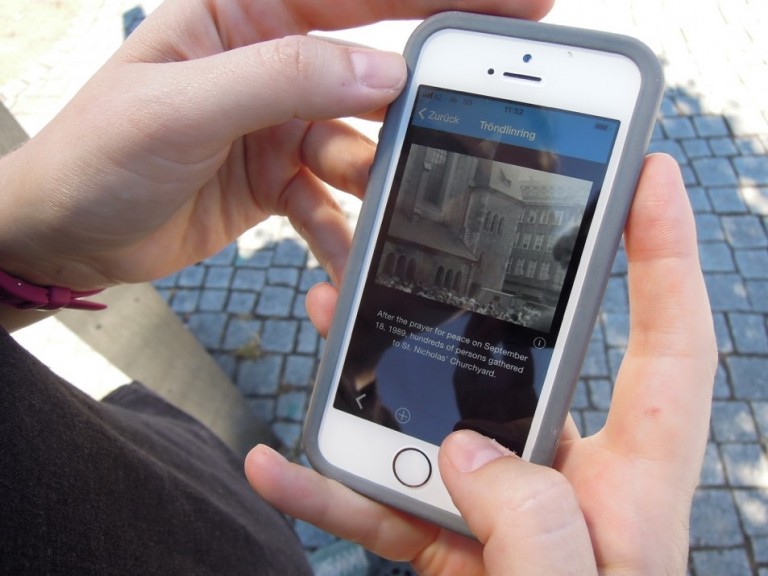
At each station, which is made from former GDR border fortifications, you can read information in German and English about a particular point in the Peaceful Revolution timeline.
With the app (available in seven languages), you can also scroll through “material” related to that event, such as photos, videos, documents, and news reports.
Unfortunately, the stations are not chronological, so you will most likely jump back and forth in the timeline as you go along. However, the app can give you a chronological view of the events to keep you on track.

The very first station we visited, positioned at Augustusplatz, set the stage for the tumultuous climate that we were going to read about.
Protests were swelling in size throughout the region leading up to October 16th, 1989. The SED regime threatened to respond with the “Chinese solution,” an ominous reference to the bloody military attack in Tiananmen Square that happened just months before.
In spite of these threats, around 120,000 people peacefully gathered and gave the SED no reason for intervening with force. On the app, you can watch surveillance camera recordings of the crowd forming and chanting as they move through the Leipzig city center.
This powerful conviction of nonviolence ultimately carried the movement to the fall of the Berlin Wall just a few weeks later.
The stations on the Peaceful Revolution-related tour can be easy to miss, so I encourage you to take the time to seek them out. Some stand in between trees in the middle of a plaza. Some are set in a wall next to people eating at a cafe. One is almost hidden under a tree on the side of Nikolaikirche.
The reward of finding these markers is learning about the events, both big and small, that revolutionized a dangerous culture. For example, today, it is completely normal to pass by street musicians in the center. In fact, we passed three different acts the day we made our tour.
But according to the station just outside of Thomaskirche, music on the street was an act of defiance in 1989.
On June 10th of that year, as unrest in the GDR grew, several musicians, many of who came from outside of Leipzig, formed a street music festival in the center. Police responded with the violent arrests of many musicians and by-standers, which impelled citizens to protest in solidarity with the arrested.
Each step along the tour adds to the picture of how the people in Leipzig and throughout the GDR uniquely fought against power.
One of the most striking moments we learned about during our tour took place at the station for November 6th, 1989, right outside the mall.
Here we read about a whopping 500,000 people who marched peacefully in the pouring rain to call for a reduction of GDR power, as well as free elections and freedom to travel. Looking around, I tried to imagine such a crowd – that’s almost as big as the population of Leipzig – passing in front of us where trams were rolling by.
While we scrolled through the photos on the app of the massive crowd covered with umbrellas, we could compare it to the scene in front of us today.

The magnitude of the moment came into focus from this view.
The Leipzig ’89 project, which was created to preserve these events’ “specificity, complexity and uniqueness”, was funded by the Federal Foundation for the Reappraisal of the SED Dictatorship, the State of Saxony, and the City of Leipzig. The Citizens Committee, which maintains the Runde Ecke (also one of the stations on the tour), gathered the historical information and documents “to demonstrate the value of freedom and self-determination as well as the dangers of totalitarian ideologies.”
What stayed with me the most after I did the tour was the total commitment that so many people had to nonviolence. It is clear the regime was ready to retaliate on the slightest provocation. Yet the protesters worked hard to not give them the opportunity.
That’s not to say there were no victims or that the police didn’t try to exert force. But through this approach, the momentum of the Peaceful Revolution was unstoppable.
If you’re an urban explorer, this tour is the perfect way to engage with the history of this revolution. Personally, I appreciate self-guided tours because I can control the routes I take, how fast or slow I walk, or even pause for fries along the way.
If you don’t feel like doing the whole tour in one go, you can visit the stations as you travel around the city regularly. You just have to start looking for the yellow signs.
There is a lot of extra material on the app to bring the Peaceful Revolution alive and help you understand the fears and impressive courage people lived with during that time.
The irony was not lost on me that we started and ended at Augustusplatz, where not too long ago a small yet mighty group of people gathered to promote peace at another border halfway around the world. It is a crucial time now to reflect on historical movements like this, when leaders are talking about building walls and strengthening borders.
It’s easy to forget that the challenges we face today are not always new. In spite of the different contexts, we can learn a lot from what came before us, especially when it’s standing right in front of us on the street.

By Hannah Sapunor-Davis
Hannah Sapunor-Davis is a freelance editor, proofreader, and copywriter. Originally from California, she moved to Leipzig four months ago by way of the Netherlands. Both her History and Arts Management research focused on the role of public art in community and cultural understanding. In her spare time, she enjoys reading, listening to podcasts, and spending time in nature.

